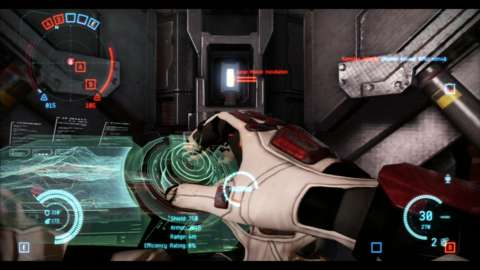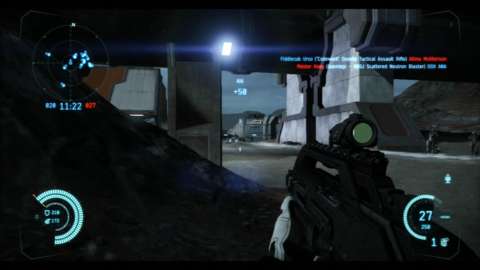One AGM-114 Hellfire air-to-ground missile costs the United States military around $70,000 each time a drone operator pulls a trigger, which, the army boasts, has happened more than 11,000 times since 2001. It's this colossal expenditure of resources that drives the gears of the war machine: usage creates demand, and demand creates billions of dollars in revenue. All that money considered, it's a surprise that the games industry has been so slow on the uptake. While free-to-play mobile games have begun charting the waters of the microtransaction with purchasable boosters and depleting "energy" systems, billion-dollar stalwarts like Call of Duty remain moored to reliable models: compelling gameplay and annual full-price iterations. In this Skinner box factory, intended obsolescence is the name of the game. Then, in steps Icelandic developer CCP, contriving to build a better mousetrap. Dust 514 is the result.
What if an online shooter persisted, receiving patches and features instead of ceding the floor to its next of kin? What if it aspired to build a world beyond menu screens and battle arenas? What if every death had an associated dollar value, a sunk cost in munitions and equipment? Those are the questions Dust posed before its release last May, and they were questions worth asking. But it has become increasingly clear that the game's answers just won't do. It has taken some time to feel comfortable making that proclamation, because CCP's flagship game EVE Online is the poster child for delayed success. EVE survived its inauspicious debut by doggedly improving upon its initial offering. Dust 514 has improved too, reaching version 1.7 just this past week. It's tempting to wonder if the cure to the game's ills lies in some such string of coming patch notes, but unfortunately, Dust's problems are innate.
Dust 514 shares more than just a design ethos with EVE Online; the two games occupy the same server, too. The shooter is intended to complement EVE's space-faring massively multiplayer role-playing game, where player corporations vie for military and economic supremacy. Players in Dust assume the role of mercenary soldiers, contracted by corporations in EVE to battle over planetary resources. The battles play out as isolated skirmishes, either to control key points on the map or to diminish the other side's supply of tickets (here, clone reserves). Barring a bit of new phraseology about "virus uploads" or "NULL cannons," it's familiar territory for veterans of other first-person shooters, sci-fi or no.
Really, for all the future trappings, Dust's version of war is fairly of our time. Infantry scurry about, securing objectives and shooting projectiles into one another. Tanks and stationary turrets fire. Vehicles with rear-mounted machine guns roam about, shuttling troops to the front lines. Even the game's much-ballyhooed orbital strike, in which EVE players are dialed up for a quick extraterrestrial bombardment, isn't all that different from a good old Hellfire missile in practice. It's an unimaginative waste of a fanciful premise; in Dust's futuristic universe, the war machine chugs on.

It's a familiar sort of dystopian cynicism--death and destruction for the sake of quarterly financial reports and shareholder portfolios--that Dust 514 carries for better and worse. It manifests in the game's fiction, with wry touches like the polite public announcements cautioning against public suicide. Or the nagging sense that a battle between armies of immortal clones is an exercise in spinning wheels. It's also visible in the beautiful future weapons that fill the storefront of the game's virtual marketplace, where the latest variants from Duvolle Laboratories and Kaalakiota Corporation occupy tiled spaces like app store entries--killing tools, the lot of them, all hawked like the year's hottest holiday item.
The most prominent positions are given to the weapons that can be had with aurum, a currency amassed through real money transactions and the cornerstone of Dust's monetization scheme. Dust encourages their purchase by implementing a lethargic rate of progression. Skill points accrued in battle can only be used toward boosts of 3 percent here, 0.5 there, never feeling substantive. It's not exactly that Dust 514 is a pay-to-win game (if only because most players don't seem to bother with the aurum-only items); it's that the progression system runs afoul of the parity most shooters work tirelessly to pinpoint. The incremental benefits Dust doles out may not feel immediately rewarding, but months of earned skills and cash eventually do add up to the point where veteran players have quantifiable advantages over newbies. In EVE, such discrepancies can be mitigated with sheer numbers or pluck. Not so in Dust, where teams are capped at 16 players and gameplay is suffocatingly rigid.
It's an unimaginative waste of a fanciful premise; in Dust's futuristic universe, the war machine chugs on.

The gameplay's more tangible issues are too numerous to recount in full. Battlegrounds are too large for the player count, resulting in long stretches where enemies are nowhere to be found. They're wastelands of muddy industrial sameness, with no attention to scale or flow. Paths dead-end nonsensically. Ladders and hallways lead to empty rooms devoid of relation to objectives or tactics. Weapon types are tremendously imbalanced. Audio effects sound cheap and have little relevance to the direction or proximity of their source. Dips in the frame rate result in distant enemies frequently looking like they're moving in stop-motion. The list goes on, but the problems run deeper.
Games like Halo and Call of Duty may be more limited in scope than Dust 514, but they can stave off any existential dread through the excitement and immediacy of their combat. Dust can make no such claims. Its poor gameplay is a taint that spreads upward from the roots, vitiating the lofty aspirations of its other features. Skill and weapon unlocks, ordinarily the cherry on top of a satisfying gaming session, morph into taunting reminders of the grind to come. The experience points, money, and items that signify forward progress become signposts that warn you're going in circles: kill to get better weapons, to kill better, to get better weapons. All the work CCP puts into crafting a larger dystopian fiction bleeds into the real experience in this fashion: you feel like a cog in a formless machine, working--not playing--in service to obscure overlords and nebulous goals.

Dust's link to EVE was supposed to provide the context for these endless war games. But the bond between the two games remains ill-defined. Corporations, the life blood of EVE, barely receive an introduction in Dust. Ditto for the former game's vast libraries of lore. Sitting in the cramped mercenary's quarters, just a few menu clicks away from jumping into battles all across the universe, it's impossible to get a sense of the vastness of space that makes the massively multiplayer online role-playing game at once so daunting and mysterious. We know that data transmits across the void between EVE and Dust, because a name taken in one cannot be used in the other. But personality never makes the jump.
A few features are cognate. The seeds of Dust's atrocious tutorial can be recognized in CCP's decade-long struggle to introduce new players to EVE. The game's preoccupation with byzantine menus is similarly rooted in EVE's history. Its player customization system is also translated from EVE's spaceship-building mechanic. In the shooter, dropsuit "fittings" are assembled from market purchases and salvage, with an eye toward available power and storage space. Yet in EVE, favored ships can often be crafted objects, built lovingly with expectations that they'll survive for as long as their pilots keep their wits about them. In Dust, death is an inevitability, and with each failure, your inventory softens. Fitting a dropsuit, consequently, begins to feel like assembly-line work. Once a viable setup has been found, it's just a matter of restocking it as necessary.
Dust 514 is an effective simulation of the economies whirring away within the military industrial complex--a farcical war to perpetuate EVE Online's inexorable cycles of death and demand. But Dust 514 needs to offer more than emerging markets for players in CCP's other, better game in order to justify its own existence.